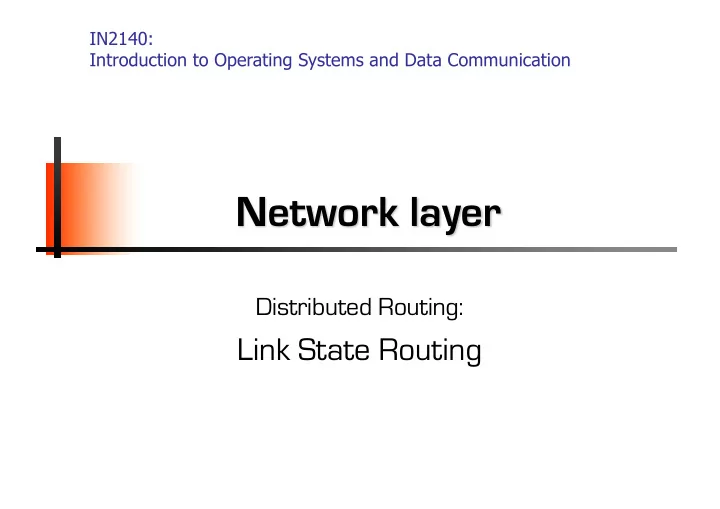

IN2140: Introduction to Operating Systems and Data Communication Network layer Distributed Routing: Link State Routing
Link State Routing § A very frequently use routing protocol − IS-IS (Intermediate System-Intermediate System) − OSPF (Open Shortest Path First) § Basic principle − IS measures the "distance" to the directly adjacent IS − Distributes information − Calculates the ideal route § Procedure 1. Determine the address of adjacent IS 2. Measure the "distance" (delay, ...) to neighbouring IS 3. Organize the local link state information in a packet 4. Distribute the information to all IS 5. Calculate the route based on the information of all IS University of Oslo IN2140 – Introduction to operating systems and data communication
Link State Routing 1. Phase: gather information about the adjacent intermediate systems H H D E D E G G B I B I A C F A C F LAN University of Oslo IN2140 – Introduction to operating systems and data communication
Link State Routing 1. Phase: gather information about the adjacent intermediate systems H H D E D E G G B I B I A C F A C F LAN N Initialization procedure § New IS − Sends a HELLO message over each L2 channel § Adjacent IS − Responds with its own address, unique within the network University of Oslo IN2140 – Introduction to operating systems and data communication
Link State Routing 2. Phase: measure the "distance" § Definition of distance needed − Usually delay − Where to measure? Topology, link utilization, etc. information Router Routing desti- link nation Process When to start timer? Routing A 0 table Fills & Updates B 3 C 1 D 4 Uses & Looks up Data packets Queues ECHO HELLO Forwarding Incoming Outgoing lines Process lines University of Oslo IN2140 – Introduction to operating systems and data communication
Link State Routing 2. Phase: measure the "distance“ § Queuing delay − Measuring without does not take load into account − Measuring with does Þ usually better G West East C B F H A E I D J § But − Possibility for oscillations (route flapping) − Once per routing table update University of Oslo IN2140 – Introduction to operating systems and data communication
Link State Routing 3. Phase: organizing the information as link state packet § Including own address, sequence number, age, "distance" § Timing problems: validity and time of sending − Periodically − In case of major changes Link State Packets: B 2 C A B C D E F 4 3 Seq. Seq. Seq. Seq. Seq. Seq. A D Age Age Age Age Age Age 1 6 B 4 A 4 B 2 C 3 A 5 B 6 5 7 E 5 C 2 D 3 F 7 C 1 D 7 E 8 F F 6 E 1 F 8 E 8 University of Oslo IN2140 – Introduction to operating systems and data communication
Link State Routing 4. Distributing the local information to all IS § By applying the flooding procedure (very robust) − Therefore sequence number in packets § Problem: inconsistency − Varying states simultaneously available in the network − Indicate and limit the age of packet, i. e. IS removes packets that are too old 5. Computing new routes § Each IS for itself § Possibly larger amount of data available University of Oslo IN2140 – Introduction to operating systems and data communication
Recommend
More recommend